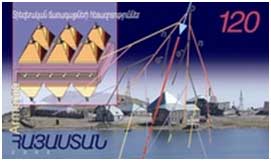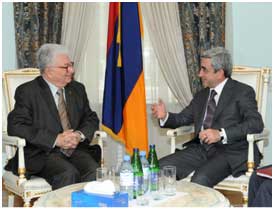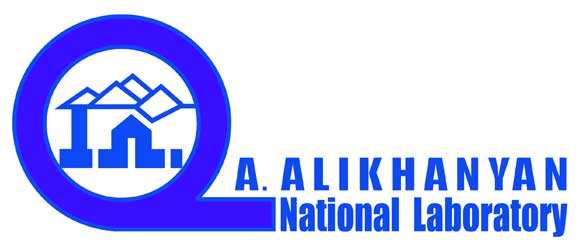Physics in the Republic of Armenia
Ani Aprahamian

The republic of Armenia is located in the mountainous region of the Caucasus. In 1991, the people of Armenia were amongst the first to take advantage of the Gorbachev’s reform movements to become an independent entity separate from the Soviet Union. The country is home to approximately 3 million Armenians with 99% literacy. Scientists in Armenia had distinguished themselves worldwide in their scientific accomplishments. Some of the most noteworthy facilities and institutions include the Observatory at Byurakan, the cosmic ray observatory on Mount Aragats (9000 ft. above sea level), the Yerevan Physics Institute, and the Armenian National Academy of Sciences.
Victor Ambartsumian who was also one of the founding members of the Armenian National Academies founded the Byurakan Astrophysical Observatory. Ambartsumian was the first to propose the existence of active galactic nuclei (AGN) 1. He was an elected or honorary member of 28 science academies around the world including the US, France, USSR, and others. Observations at Byurakan Observatory led to the identification of Markarian galaxies: a type of galaxy with unusually strong emissions at near-ultraviolet wavelengths. Astronomer Benjamin Eghishe Markarian first observed these in the 1960s.
The president of the Republic of Armenia established the Victor Ambartsumian Prize in 2009 to be awarded to outstanding scientists from any country and nationality having significant contributions in science. The Prize totals USD 500,000 and was awarded for the first time in 2010 to Prof. Michel Mayor (Observatory of Geneva, Switzerland) and his two team members for their important contributions to the study of the relationship between planetary systems and their host stars.
The Yerevan Physics Institute (YerPhi) is home to divisions of Accelerator physics, Experimental Physics, Theoretical Physics, Applied Physics, and Cosmic Ray physics. Armenia had the highest energy electron synchrotron (6 GeV) in the Soviet Union. With the construction of the CEBAF accelerator at 6 GeV at Thomas Jefferson National Laboratory in Newport News, the team of physicists from Armenia became one of the most important external collaborating groups at that laboratory. Particle physicists from Armenia designed, tested and performed the commissioning of the TOF system for the OLYMPUS spectrometer at DESY and continue with the data analysis from the HERMES and H1 experiments. There are also robust groups from YerPhi on the CMS, ALICE, and ATLAS experiments located at the LHC. The groups from Armenia work on the construction, performance optimization, and calibration of various ATLAS and CMS systems.
In addition to JLAB, DESY, and CERN, the accelerator physicists from Armenia have also been collaborating in accelerator developments at various Russian Federation Institutes including SRIERA (St. Petersburg), JINR (DUBNA), MRTI, ANSALOO-VEI (Moscow).
The last few years, there was a global shortage of 99Mo isotope for diagnostic and therapeutic procedures followed by a race to restoring a stable supply of this isotope by getting away from production of this radio-isotope via highly enriched Uranium in reactors to using (gamma, n) reactions. Today, physicists at YerPhi are engaged in research and development efforts associated with better isotope production techniques. YerPhi has just completed negotiations with IBA of Belgium towards the purchase of a cyclotron, Cyclone 18/18. This is a first step to developing a center of radioisotope production, and research in nuclear medicine. Simultaneously, It is expected that two of the 18 MeV proton beams of this new accelerator can be used to jump start a research program in radioactive ion beams.

Lightning storm detected from Mt. Aragats along with the direct observation of the secondary cosmic ray fluxes.
The Cosmic Ray Division (CRD) 2 of YerPhi is perhaps one of the most visible and active groups at YerPhi partly due to its energetic director (Ashot Chilingarian). Cosmic Ray research in Armenia has a long and accomplished history beginning in the early 1940’s. It is certainly one of the largest cosmic ray institutions in the world. The original aim of the CRD was in particle astrophysics, specifically, in studying the high-energy cosmic rays that bombard the earth. The construction of two research station sites at Nor Amberd (CRD-sites) on the slopes of Mount Aragats were amongst the first permanent high-mountain research stations built some 65 years ago3. There were early direct observations of cosmic rays made in Armenia that could not be made by satellites or balloons. Discoveries from Armenia were crucial to directly studying the particle fluxes of cosmic rays in the TeV-PeV energy region. Some of the significant past discoveries3 from the CRD include the measurements of the energy spectrum and charge ration of the horizontal muon flux and the measurements of cosmic ray spectra in the “knee” region (1014-1016 eV) of the cosmic ray spectrum using the MAKET-ANI, and GAMMA detectors in the 1980’s. The observatory on Mount Aragats was known for studying the origin and acceleration of high-energy cosmic rays but after 1991, the scarcity of resources with respect to detectors caused a shift of interest4.

After 1991, many of the scientific institutions in Armenia have experienced difficulties in re-establishing themselves and the ability to maintain or develop appropriate research infrastructure to continue doing forefront research at home in Armenia with reduced levels of financial support. Difficulties were maintaining the accelerator facilities, memberships in the international Astronomical union, the member fees at the LHC, as well as the update of the local research infrastructure and personnel.

In 2009, Professor Yuri Oganessian of the Flerov Laboratory of Nuclear Reactions in Dubna, Russia organized at the encouragement of the then minister of economy, Nerses Yeritsyan, an international committee of experts (InComEx) from the US, the UK, Germany, France, Bulgaria, Switzerland, and Russia to evaluate the scientific activities of YerPhi and to make recommendations to the government of Armenia regarding the future of the Yerevan Physics Institute. The InComEx group encouraged the government to support YerPhi and recognize it as a great national resource. The photograph shows the meeting of Dr. Oganessian of Dubna with the President of Armenia Serzh Sargsyan. The outcome was the founding of a new national laboratory of Armenia! The name of the laboratory is Alikhanyan National Laboratory to recognize the original founders of YerPhi, Abraham Alikhanov and Artem Alikhanian. The budget of the laboratory has been doubled and enthusiastic activities continue.
In conclusion, the government of Armenia has realized the importance of science and new discoveries in creating an innovative economy and supports the new national laboratory of Armenia as a way to get there.

References:
1. “Problems of Physics and Evolution of the Universe”, a collection of papers published on the occasion of Ambartsumian’s 70th birthday, edited by L. V. Mirzoyan, publishing house of the Armenian Academy of Sciences, Yerevan (1978).
2. http://www.yerphi.am/cms/pr.phy?id=38
3. “Cosmic Ray research in Armenia”, A. Chilingarian, R. Mirzoyan, and M. Zazyan, Advances in Space Research, Vol 44, 1183 (2009).
4.“Armenia detects space weather”, Daisy Yuhas, Symmetry, Vol. 7, issue 5 (2010).
5.“Ground-based observations of thunderstorm correlated fluxes of high energy electrons, gammas, and neutrons”, A. Chilingarian, A. Daryan et al., Phys. Rev. D 82, 043009 (2010).
6. http://science.nasa.gov/science-news/science-at-nasa/2011/11jan_antimatter/
Ani Aprahamian is the Frank M. Freimann Professor of Physics at the University of Notre Dame
Disclaimer - The articles and opinion pieces found in this issue of the APS Forum on International Physics Newsletter are not peer refereed and represent solely the views of the authors and not necessarily the views of the APS.
